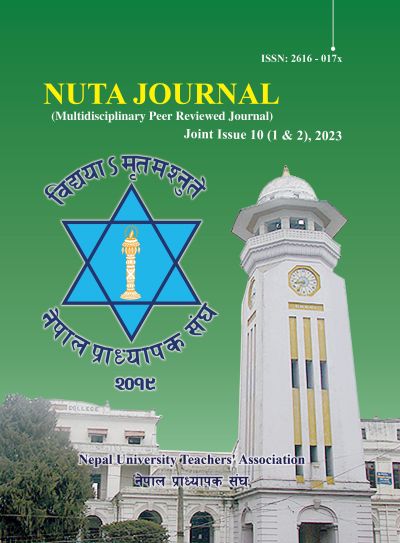नाटककार विजय मल्लको रङ्गमञ्च शिल्प {Dramatist Bijay Malla's art of theater}
DOI:
https://doi.org/10.3126/nutaj.v10i1-2.63055Keywords:
कार्यव्यापार, तादात्म्य, रङ्गकर्मी, रङ्गमञ्च, रुपकत्व, सात्त्विक, Business, identity, actors, theater, metaphot, purityAbstract
प्रस्तुत लेख विजय मल्लका नाटकको रङ्गमञ्चशिल्पको अभ्ययनमा केन्द्रित छ । रङ्गमञ्चशिल्पको वैशिष्ट्य निरूपण नाटकको रङ्गमञ्चीय प्रस्तुतिका रूप र अवस्थाको प्रत्यक्ष अवलोकनबाट हुन्छ तापनि रङ्गमञ्चीय प्रस्तुतिका समस्त रूप र अवस्थाको मूलाधार नाट्यमर्म हो । नाट्यमर्मलाई नै श्रव्यदृश्य परिणति प्रदान गर्ने उद्देश्यले नै आधारशिलाका रूपमा नाट्यपात्रका कार्यव्यापार सम्पत्र भएको स्थान, समय र परिस्थितिको प्रतिनिध्यात्मक वा प्रतीकात्मक ढङ्गमा रङ्गमञ्च तयार गरिन्छ । नाट्यकृतिलाई रङ्गमञ्चीय प्रस्तुतिमा लैजाँदा रङ्गकर्मीहरूले नाट्यालेखको अध्ययनबाट नाट्यपात्रका बाह्यान्तरिक रूप र अवस्थाको मानससाक्षात्कार गर्छन् र तत्सदृश रूपधारण गरी अन्यान्य भौतिक उपकरण र कलारूपहरूको समन्वयमा नाट्यमर्मलाई अभिनय कलामा रूपायन गरी श्रव्यदृश्य परिणति प्रदान गर्छन् । यस अवस्थामा रङ्गमञ्च नाटककारको सृजनकर्म, नाट्यमर्म र रङ्गकर्मीका रङ्गकर्मलाई सार्थकता प्रदान गर्ने एक मात्र आधारशिला रङ्गमञ्च बन्छ । त्यसैले रङ्गमञ्च भत्रु मानवरहित भौतिक संसार नभई रङ्गरमाइलो गर्न बनाइएको भौतिक संसारका विविध रूप, अवस्था र कलाकर्मीका रङ्गकर्मको समष्टि हो । यो रङ्गकर्मस्थल विशेषले समष्टिमा दर्शकलाई आनन्दानुभूति त गराउँछ नै; पूर्वदीप्तिका रूपमा नाट्यपात्रको व्यापक पृष्ठभूमि सङ्केत गरी नाट्यावलोकन गर्ने अभिरुचि पनि जगाइदिन्छ । नाट्यकृतिको रचना रङ्गमञ्चीय प्रस्तुतिका लागि रचिने र रङ्गमञ्चीय प्रस्तुतिमा नै यसले आफ्नो सार्थकता सिद्ध गर्ने हुनाले नाटकको मूल्याङ्कन रङ्गमञ्चीय शिल्पसौन्दर्यसँग जोडेर गरिनुपर्छ । तर अध्ययन परम्परामा विजय मल्लको रङ्गमञ्चशिल्प वैशिष्ट्य निरूपणलाई केन्द्रीय विषय बनाएर विशिष्टीकृत अध्ययन भएको पाइँदैन । यो अध्ययनले यही रिक्तता मेटाउनमा लक्षित छ । त्यसैले यो अध्ययन महत्त्वपूर्ण रहेको छ । प्रस्तुत अध्ययन गुणात्मक प्रकृति रहेको छ । पूर्वीय तथा यथार्थवाद र यथार्थवादोत्तर पाश्चात्य नाट्यमान्यता र पद्धतिबाट प्रेरित र प्रभावित विजय मल्लको नाट्यशिल्पी नूतन प्रयोगधर्मी रीतिबाट गतिशील भएको र उनको रङ्गमञ्चशिल्पको मूल्याङ्कन कुनै खास नाट्यमान्यता र शिल्पपद्धतिबाट हुन नसक्ने भएकाले पूर्वीय तथा यथार्थवाद तथा याथार्थवादोत्तर प्रयोगधर्मी नाट्यमान्यताको समन्वयबाट तथ्यहरूको विश्लेषणका लागि सैद्धान्तिक अवधारणा तयार परिएको छ । सोही ढाँचाअनुसार तथ्यको वर्णन तथा विश्लेषण गरिएको छ । रचनात्मक स्तरमा पहाड चिच्याइरहेछ र भोलि के हुन्छ ? नाट्यकृतिमा उच्च प्रयुक्तिको प्रयोगधर्मी शिल्प अवलम्बन गरिकोले यी दुई नाटकको रङ्गमञ्चशिल्प नाटकीय गुणसम्पदाले समृद्ध हुँदाहुँदै पनि उच्च प्रयोगधर्मी जटिलतातर्फ उन्मुख रहेको छ भने बाँकी नाटकका रङ्गमञ्चहरू सरल, सहज, समस्त नाटकीय गुणविशेषताले समृद्ध छन् । रचनात्मक स्तरमा सृजित हुने रङ्गमञ्चशिल्प पनि नाटकीय गुणविशेषताले समृद्ध हुने देखिन्छ र सबै नाट्यकृति रङ्गमञ्चीय प्रस्तुतिप्रदर्शनका दृष्टिले अभिनेय र दर्शकको संवोगात्मक जीवनलाई उद्दीप्त पार्न समर्थ देखिन्छन् भत्रे यस अध्ययनको निष्कर्ष हो । {The presented article is focused on the study of stagecraft of Vijay Malla's play. The characteristic of stagecraft is through the direct observation of the form and condition of the stage performance of the play, but the basis of all the forms and conditions of the stage performance is drama. With the aim of providing an audio-visual result to the drama itself, the stage is prepared in a representative or symbolic manner of the place, time and situation where the action of the character is the foundation stone.When taking the play to the stage performance, the actors study the external form and condition of the character through the study of the script, and in the coordination of other physical devices and art forms, they transform the drama into an acting art and give an audio-visual result. In this situation, the stage becomes the only cornerstone that gives meaning to the creativity of the dramatist, the drama and the performance of the artists.Therefore, Rangamancha Bhatru is not a physical world devoid of human beings, but a collection of various forms, conditions, and artistic actions of the physical world made to be colorful. This special venue not only brings joy to the audience as a whole; It also awakens the interest to observe the drama by indicating the broad background of the character as a prelude.Since the composition of the play is composed for the stage performance and it proves its worth in the stage performance, the evaluation of the play should be done in connection with the artistic beauty of the stage. But in the study tradition, it is not found that there has been a specialized study by making the representation of Vijaya Malla's color and theater characteristics as a central topic. This study aims to fill this gap.Therefore, this study is important. The present study is qualitative in nature.Inspired and influenced by eastern and realism and post-realism western theatrical values and methods, Vijay Malla's dramaturgy is moving in a new experimental way and his stagecraft cannot be evaluated by any specific theatrical values and craft methods, so a theoretical concept has been prepared for the analysis of the facts through the coordination of eastern and realism and post-realistic experimental theatrical values.According to the same format, the facts have been described and analyzed. On a creative level, the mountain is screaming and what will happen tomorrow? Due to the adoption of highly applied practical art in the drama, the stage art of these two plays is rich in dramatic qualities, but is oriented towards high practical complexity, while the rest of the plays are simple, easy, and rich in all dramatic qualities.Theater art that is created at a creative level seems to be enriched with dramatic qualities and all plays are capable of stimulating the emotional life of the actors and the audience from the point of view of theatrical performance, according to the conclusion of this study.}
Downloads
Downloads
Published
How to Cite
Issue
Section
License
© Copyright by NUTA JOURNAL
All Rights Reserved. No part of this Journal may be reproduced in any form or by any electronic or mechanical means, including information storage and retrieval system without prior permission in writing from the publisher, except by a reviewer who may quote brief extracts while reviewing.

